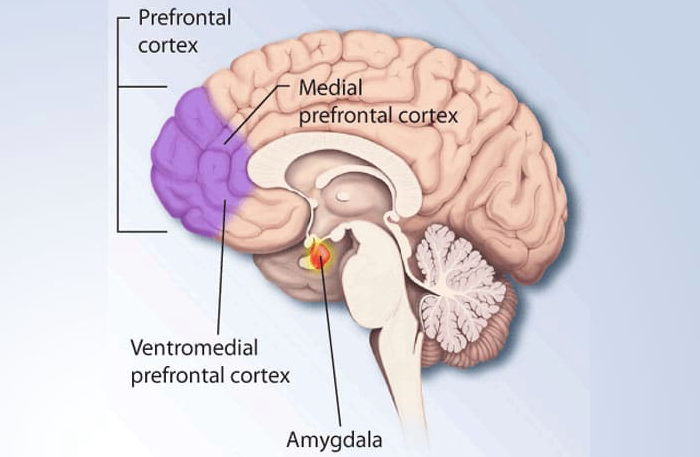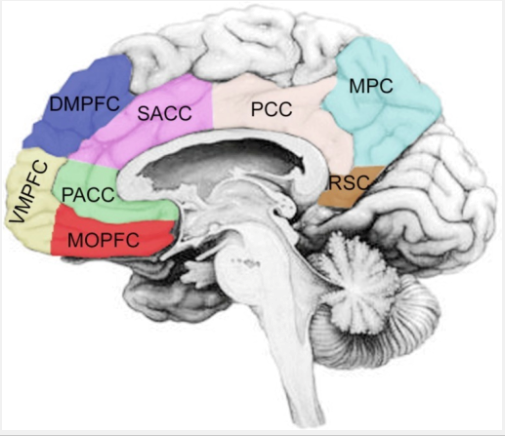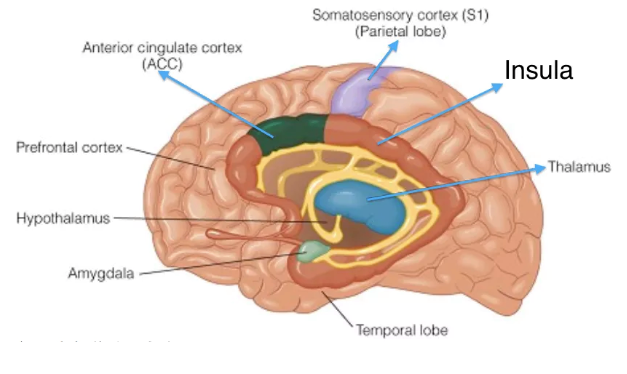Consistent meditation on a daily basis is beneficial in several ways. The benefits can be noticed experientially by the practitionres.
Scientific studies have shown proof of long term changes in the brain. Many people are skeptical about the effects of meditation, hopefully some exposure to scientific literature will make them realize the potential effects.
Science has realized the plasticity of the human brain. As we reach adulthood, we learn that the brain is somewhat plastic because we are somewhat able to change aspects of our behaviour. We can develop responses that are more considerate and less reliant on deeply rooted neural patterns defined by natural instincts related with survival.
The following areas of the brain are important in the effect of meditation and must be understood to get a sense of what is happening in the brain.
Lateral Prefrontal Cortex:
 This area of the brain involved is in broad areas of behavioral control and planning of behavior. It allows you the ability to look at things more rationally, while being able to modify emotions. It is involved in overriding instinctive behavior and habits and also in lowering the act of taking things personally. This can be referred to as the “Assessment Centre.”
This area of the brain involved is in broad areas of behavioral control and planning of behavior. It allows you the ability to look at things more rationally, while being able to modify emotions. It is involved in overriding instinctive behavior and habits and also in lowering the act of taking things personally. This can be referred to as the “Assessment Centre.”
Medial Prefrontal Cortex:

The medial prefrontal cortex is involved in self-referencing. It is often called the “Me Center”. It is focused on reference back to yourself, your experiences and perspective. It is involved in processing information during times of daydreaming, reflecting on oneself, future thinking, social interactions and empathy for others.
This medial prefrontal cortex is then divided into multiple sections. The vmpfc and Dmpfc are important in the context of meditation.

Ventromedial Prefrontal Cortex:
This area is involved in processing information related to people that are viewed as similar to you. This area can be attributed to taking things personally. It has many helpful aspects but in regard to meditation, it is the negative aspect of the self-referencing brain. It focuses on rumination and worry and can enhance depressive and anxious feelings and thoughts.
Dorsomedial Prefrontal Cortex:
This area is involved in processing information to people who are viewed as dissimilar to you. This area can be attributed to feeling of empathy, mostly dealing with people we perceive as different from us. It is also important in keeping social connections.

Insula:
This area is always gathering information about bodily sensations and plays part in “gut-level” feelings. It helps determine how strongly the individual will response to bodily sensations, like danger. It also plays large role in feelings of empathy.
Amygdala:
This area of the brain is commonly referred to as the “Fear Center.” It acts as the alarm system of the brain and causes most of our automatic emotional responses, like the “fight-or-flight” response.
Brain Without Meditation:
Before a meditation, an individual's brain would show strong neural connections within the Me Center and between the Me Center and the fear and bodily centers of the brain. This means that whenever there is a sensation in the body or a feeling of anxiety or fear, the individual is more likely to assume there is a safety problem. This is caused by the majority information processing by the Me Center. Also, dominance of the Me Center can explain how we get stuck ruminating about thoughts, moments in our life, how people perceive us and trying to justify the sensations in our body.
Normally, the connection between the Assessment Center and the Me Center is weak. In a situation where the Assessment Center were to process more information, it would have better control of the vmPFC (unhelpful) and increase dmPFC (helpful) activity. This would allow a better filter for information, as a more balanced and realistic view would be achieved. The Me Center would be less able to ruminate. In other words, this would decrease overthinking, rumination and anxiety.
Brain with Meditation:
A constant meditation practice can have many effects on the brain regions that have been discussed so far. Initially, the strong connection between the Me Center and fear and body centers begins to diminish. This will take away the panic from a bodily sensation or fearful feeling and will take away blame of self for the problem. This is very evident in anxiety, as meditation is shown to decrease it. Due to increased Assessment Center activity, it is easier to observe unwelcome sensations and not immediately react to them.
On the other hand, the Assessment Center and fear and body centers begin to form stronger connections. This allows more rational thought perspective when experiencing body sensations or dangerous situations. Another added benefit is improved connections between the dmPFC (helpful) regions and the body sensation center that is involved with empathy. This enhanced connection allows better understanding of other people and their behavior, especially those who you perceive as very different from you. It also improves the ability to understand what is going on in with other people and their motivations. At the same time, the insula is activated, which is actually responsible to for the actual feeling of empathy.
Overall, meditation has been proven to change neural connections in the brain. It helps in making healthier neural connections that allow for more rational and balanced responses which process information more thoroughly before responding. All of this does not happen overnight, but a constant meditative practice like deep breathing will prove its benefits over time. Little things will be noticeable in everyday life.
Acknowledgements:
https://www.ncbi.nlm.nih.gov/pubmed/18195082
https://www.sicotests.com/psyarticle.asp?id=191
https://openi.nlm.nih.gov/detailedresult.php?img=PMC3431612_fpsyg-03-00303-a001&req=4